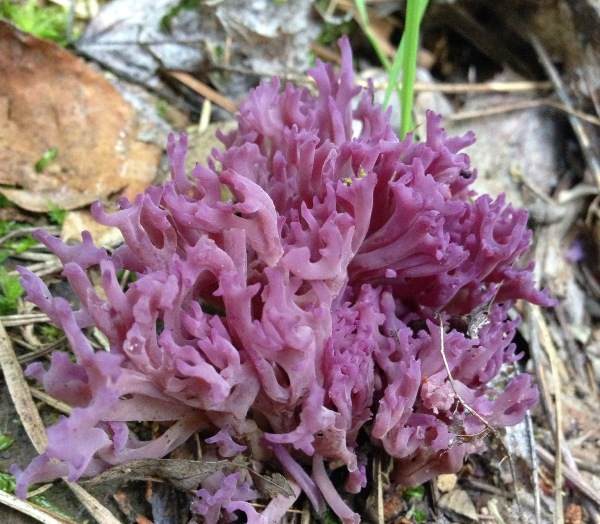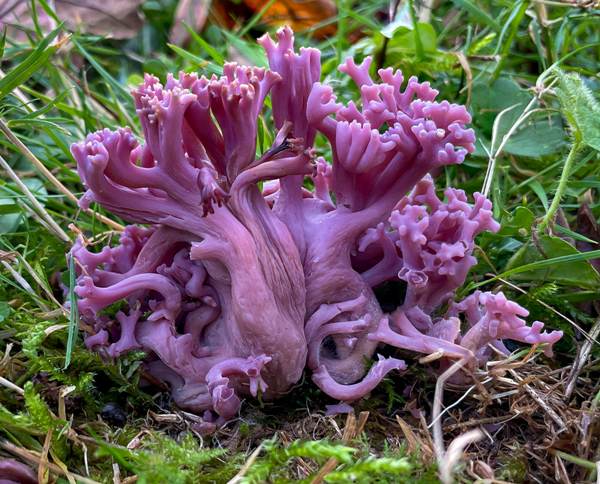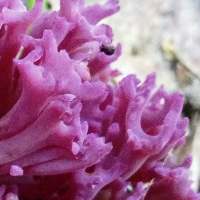Trees Birds Mammals Fish Amphibians Reptiles
Wild Algarve
Bookshop
Clavaria zollingeri Lév. - Violet Coral
Phylum: Basidiomycota - Class: Agaricomycetes - Order: Agarcales - Family: Clavariaceae
Distribution - Taxonomic History - Etymology - Identification - Reference Sources

This beautiful violet coral-like fungus is found only very occasionally. The dichotomously
branching fruitbodies can be up to 10cm tall and are initially violet but become dull grey-brown when old. It is an inedible species and is so rare that it should not be gathered except for important research.

Distribution
Rare in Brtain and Ireland, most records are from Wales and England with just a few known sites in Northern Ireland and Scotland. This species is much more common in some eastern parts of North America.
Taxonomic history
Described in 1846 by French mycologist Joseph-Henri Léveillé (1796 - 1870), this fairy club fungus was given the scientific name Clavaria zollingeri which has been generally accepted as its basionym.
Synonyms of Clavaria zollingeri include Clavaria amethystina, Clavulina amethystina, and Clavaria lavandula Peck.
Etymology
The specific epithet honours Swiss botanist Heinrich Zollinger (1818 - 1859), who specialised in the study of the genus Clavaria.
Identification Guide
 |
Initially pale to deep violet, this very coral-like fungus can have rounded or moderately angular tips to its outer branches.
The whole fruitbody is 3 to 10cm tall and
usually of similar width. The individual stems are
typically 4 to 7mm across their major diameter. |
| |
Spores
Broadly ellipsoid to subglobose, smooth, 4-7 x 3-5µm.
Spore print
White.
Other microscopic characters
The basidia are four spored, and there are no clamp connections; this differentiates Clavaria zollingeri from the macroscopically similar Clavulina amethystina, a European species which has two-spored basidia and clamp connections between hyphal sections. |
Odour/taste |
Not distinctive. |
Habitat & Ecological role |
In broadleaf and coniferous woodland as well as in high quality (unimproved) grassland including old lawns, parks, churchyards and sheep-grazed pasture. Gait Barrows National Nature Reserve, Lancashire, England, and Rothiemurchas, near Aviemore in Scotland are two sites where this species is seen fairly frequently. |
Season |
July to November in Britain and Ireland. |
Occurrence |
Rare in Britain and Ireland but fairly common in eastern parts of Northy America. |
Similar species |
Clavulinopsis umbrinella is a pinkish beige grassland species with a fused stem base that is paler than its branches.
Clavulina rugosa is
smaller and white with one or just a few club-like branches with blunt tips. |
Reference Sources
Fascinated by Fungi, 2nd Edition, Pat O'Reilly 2016, reprinted by Coch-y-bonddu Books in 2022.
Dictionary of the Fungi; Paul M. Kirk, Paul F. Cannon, David W. Minter and J. A. Stalpers; CABI, 2008
Léveillé JH. (1846). "Descriptions des champignons de l'herbier du Muséum de Paris". Annales des Sciences Naturelles, Botanique. III - 5: 111–67.
Mitchel D. "Clavaria zollingeri – the violet coral". Northern Ireland Priority Species. National Museums Northern Ireland. Missing or empty |url= (help); |accessdate= requires |url= (help)
Taxonomic history and synonym information on these pages is drawn from many sources but in particular from the British Mycological Society's GB Checklist of Fungi.
Acknowledgements
This page includes pictures kindly contributed by Billie Becker and Tomas Milan.
Top of page...
Fascinated by Fungi. Back by popular demand, Pat O'Reilly's best-selling 450-page hardback book is available now. The latest second edition was republished with a sparkling new cover design in September 2022 by Coch-y-Bonddu Books. Full details and copies are available from the publisher's online bookshop...